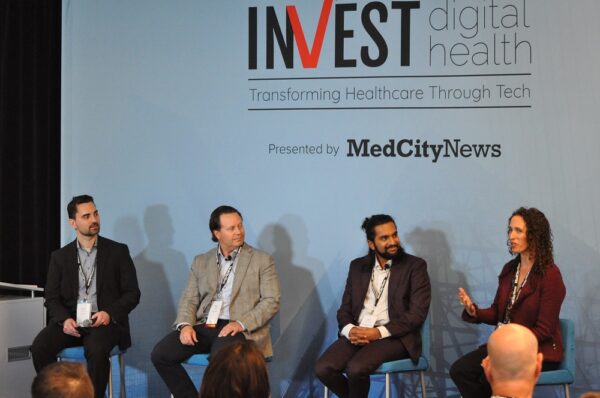
From left to right: Aaron DeGagne, Rick Anderson, Smit Patel, and Shira Butler.
Pear Therapeutics aimed to disrupt healthcare by offering software as medicine. Though the company succeeded in bringing three prescription digital therapeutics products to the market, Pear was less successful at getting sufficient prescriber and payer buy-in. Earlier this year, the company’s assets were auctioned off in bankruptcy court.
The Pear bankruptcy still looms over the emerging digital therapeutics industry, which is trying to learn lessons from the company’s fall. Perhaps one lesson is to be only slightly disruptive. While disruption can be good for healthcare, it might be better to try and disrupt one thing at a time. Pear tried to change not only how payers provide care, but also how payers reimburse for it.

With the Rise of AI, What IP Disputes in Healthcare Are Likely to Emerge?
Munck Wilson Mandala Partner Greg Howison shared his perspective on some of the legal ramifications around AI, IP, connected devices and the data they generate, in response to emailed questions.
“There’s a part where payers are still learning,” said Smit Patel, associated program director at the Digital Medicine Society. “Right now there’s no benchmark for comparing digital therapeutics and digital medicine products with the standard of care.”
Patel spoke on a panel during the MedCity News INVEST Digital Health conference held in Dallas on Thursday. He was joined by Rick Anderson, president of DarioHealth, and Shira Butler, vice president, provider growth and operations, at Lin Health. The panel was moderated by Aaron DeGagne, a healthcare research analyst at Pitchbook.
Lin, a Denver-based startup, has commercialized technology that helps patients manage pain. The offering is an app that guides patients through a customized care plan to change how they think about their pain. Butler said that rather than pursuing a prescription path, the packaging of the offering as a tech-enabled service enabled the startup to go to market sooner and at lower costs. The failure of Pear and others to achieve rapid growth in the use and reimbursement of prescription digital therapeutics could mean others will follow the nonprescription path Lin is pursuing, Butler said.
Anderson said the digital therapeutics industry will ultimately reach a place with clear pathways for what regulators and payers are looking for. In time, commercialization could more closely resemble the drug sector, where clinical-stage biotechs strike up partnerships with big pharmaceutical companies to steer these technologies through regulatory review and ultimately into revenue-generating products.
“That just doesn’t exist in digital therapeutics at the moment,” Anderson said. “I think there’s reason to believe that it will. Pharma will come to this market eventually. In the meantime, we’re going to see, especially in this macroeconomic environment, people pursue other pathways.”
Some perspective is needed, Patel said. It took more than two decades for personal computers to achieve 40% adoption, he noted. Internet use took 13 years to achieve 40% adoption. Even though the Covid-19 pandemic sparked excitement about the promise of digital therapeutics, this industry is still relatively new. Anderson said one of the challenges for healthcare technologies adoption is that clinicians set workflows, and they can be slow to change. One way to spur that change is by generating good data. Dario has been working with Sanofi in a partnership that has the two companies co-promoting some of Dario’s offerings. Data generated from those technologies will be used to develop new products and services. Anderson said Sanofi has taken Dario’s data through a real-world, pharma-based analysis. The health plans and self-insured employers that are Dario’s customers want to see proof that these technologies improve outcomes.
“Chronic conditions is what happens between doctor visits,” Anderson said. “If you can help manage that, I think that’s where we’ll see the adoption.”
Another challenge facing the digital therapeutics sector is the sheer number of players in this market. There are numerous point solutions, which are technologies that tackle a single health condition. But Anderson said that stakeholders are looking for platform solutions able to address a wider range of conditions. Patel said more and more point solutions will not solve anyone’s problems. Patients will also help push these players toward consolidation.
“At the end of the day, a chronic patient specifically would not want to have seven different [digital therapeutic] apps on their phone,” Patel said.














